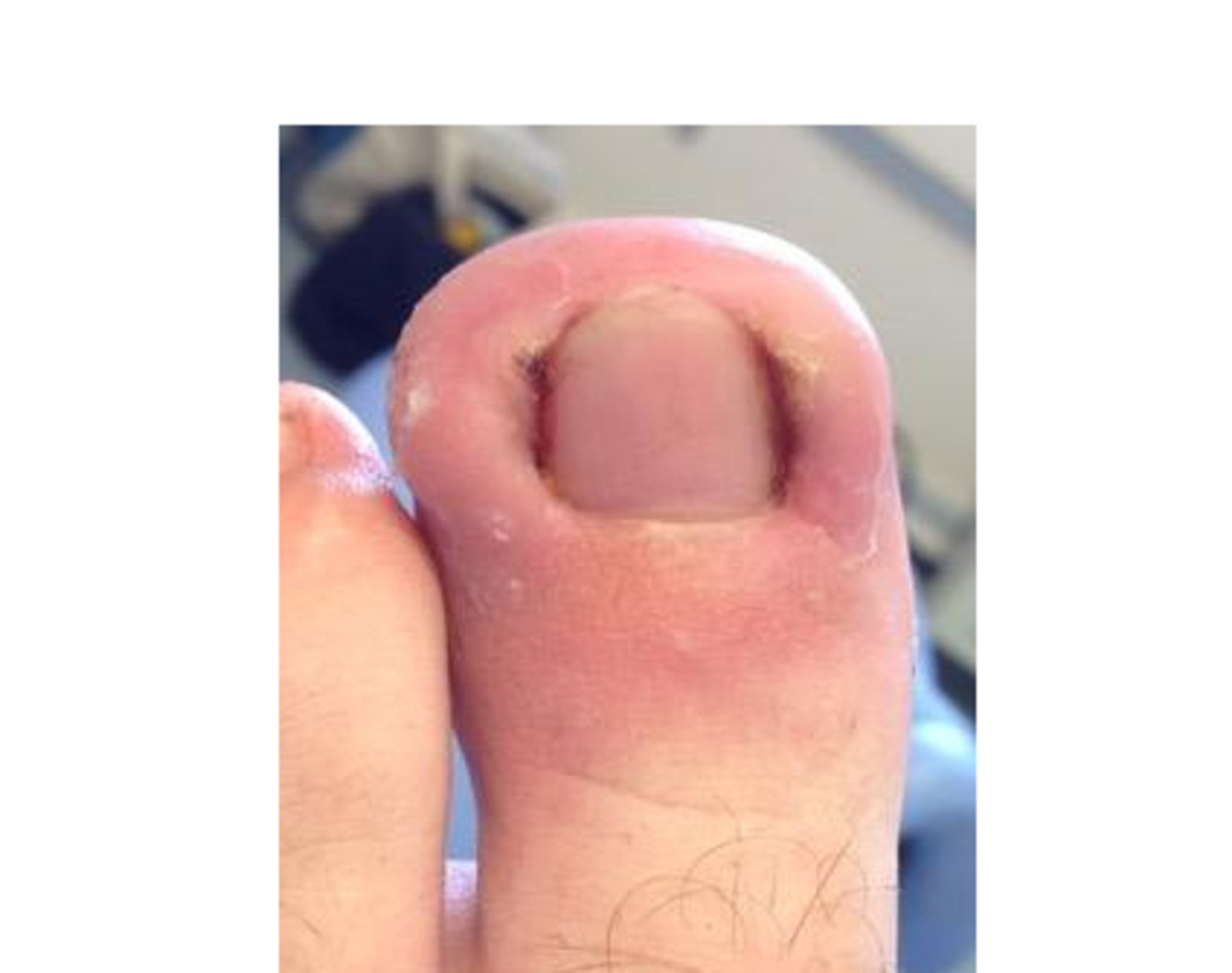
What is an Ingrowing Toenail?
An ingrowing toenail is one that pierces the flesh of the toe. It can feel as if you have a splinter, and can be extremely painful. In more severe cases, it can cause pus and bleeding. Ingrowing toenails most commonly affect the big toenail, but can affect the other toes too.
A nail that is curling (involuted or convoluted) into the flesh, but isn’t actually piercing the skin isn't an ingrowing toenail, but can feel very painful and also appear red and inflamed as well.

Who gets ingrowing Toenails?
Active, sporty people are particularly prone, because they sweat more. Younger people are more likely to get it (as they pick their nails more, compared to older people who may not reach their toes!) Women often develop them as a result of cutting nails too low in order to relieve the pressure and discomfort of an involuted nail.
Are Ingrowing Toenails serious?
If left untreated, the infection can spread to the rest of the toe. The quicker you treat it, the less painful the treatment.
What causes Ingrowing Toenails?
There are many genetic factors that can make you prone to ingrowing toenails, including your posture and how you stand, your gait and the way in which you walk, foot deformities such as bunions, hammer toes, or excessive pronation of the feet, which is when your foot rolls in excessively. With genetic factors, it's possible that your nails naturally splay or curl out instead of growing straight, which is what encourages your nail to grow outwards or inwards directly into the flesh.
Other causes of ingrowing toenails could be due to wearing tight footwear such as tight hosiery or tight socks, excessive sweat, and lack of diversity in your footwear. This can make the skin around your nails too moist and changes the way the nails grow, making it more likely to get an ingrowing toenail. However, one of the most common causes is not cutting your toenails properly.
Treatment
Surgical Correction
If you are particularly prone to ingrowing toenails from underlying problems such as poor gait, your podiatrist may recommend correction of the underlying problem as well as a more permanent solution to the nail itself, such as partial nail avulsion (PNA). This is done under a local anaesthetic, where 8-10% of the nail is removed (including the root) so that the nail permanently becomes slightly narrower. The chemical phenol cauterises the nail and prevents it regrowing in the corners. This is 97-98% successful. You will, however, have to go back to your podiatrist for a number of re-dressings.
What can I do?
Firstly, make sure to learn to cut your nails properly. Avoid using nail cutters as they have a curved cutting edge which can damage and cut the flesh. Instead, use nail clippers. Nail clippers are available from chemists and are safer to use because of their small cutting blade and long handle. When cutting your nails, you should cut straight across, not curved, and don't cut too low at the edge or down the sides. Ensure the corner of your nails are visible above the skin. The best time to trim your nails is immediately after taking a bath or shower when they are soft, or alternatively after soaking them.
Having good hygiene can go a long way to preventing ingrowing toenails. One of the ways you can avoid moist, soggy feet is by ensuring you rotate your footwear so each pair has a chance to dry out thoroughly. Avoid man-made materials, choose socks and shoes of natural fibre, and in the summer, wear open-toed sandals where possible.
If you have noticed problems with your feet such as ingrowing toenails and have booked an appointment with a podiatrist, try to relieve your discomfort until the appointment by bathing your foot in a salty footbath. This action can prevent infection and reduce inflammation. Following that, apply a clean sterile dressing, especially if you have a discharge, and rest your foot as much as possible.
If you have diabetes, are taking steroids, or are on anti-coagulants, don’t attempt to cut your nails or remove the ingrowing spike of nail yourself.
What can a podiatrist do?
It depends on the severity of your condition. For the most basic painful and irritable ingrowing toenail, your podiatrist will remove the offending spike of nail and cover with an antiseptic dressing. However, if your toe is too painful to touch, your podiatrist may inject a local anaesthetic before removing the offending portion of nail to ease the pain.
If you have involuted nails, your podiatrist may remove the bit that’s curling into the flesh and file the edges of the nail to a smooth surface.
If you have bleeding or discharge from an infection, or even excessive healing flesh (hypergranulation tissue) around the nail, you’ll need antibiotics to beat the infection as well as having the offending spike removed.
You may visit your podiatrist and discover you do not actually have an ingrowing toenail, but instead curly nail which has a lot of debris, dirt and fluff stuck underneath it, or a corn or callus down the side of the nail which is equally painful. The difference between an ingrowing toenail and a corn could be the pain level - if you have a corn the pain can be described as a throbbing sensation, whereas for an ingrowing toenail it is more of a sharp pain. If you have curly nail, your podiatrist will remove the debris, and if necessary, thin the nail.
© Walkwel Ltd 2025.
Registered in England #08928649
Registered VAT Number: GB121089836
An indicoll website
Privacy PolicyCookie PolicyDisclaimerAccessibility
